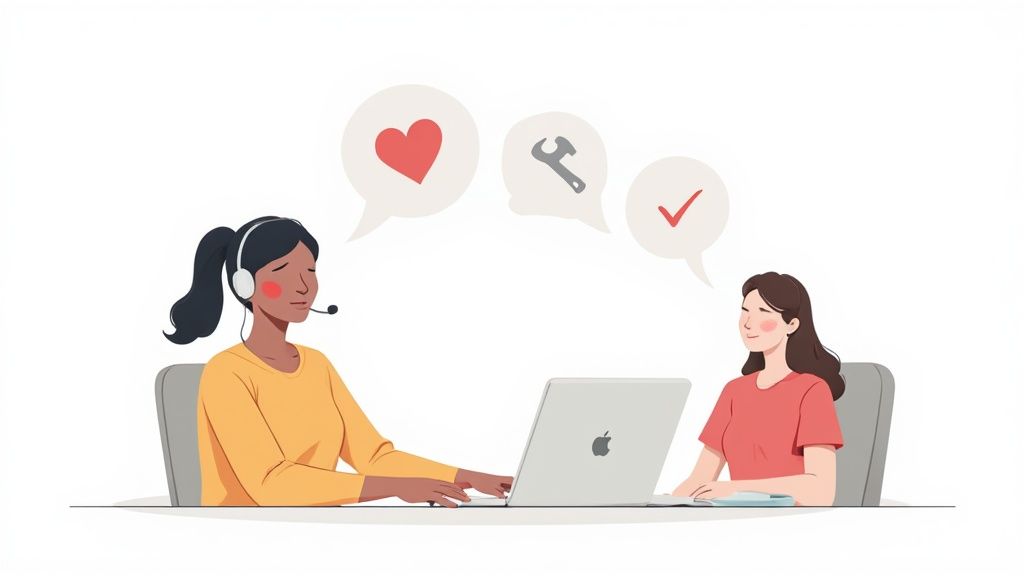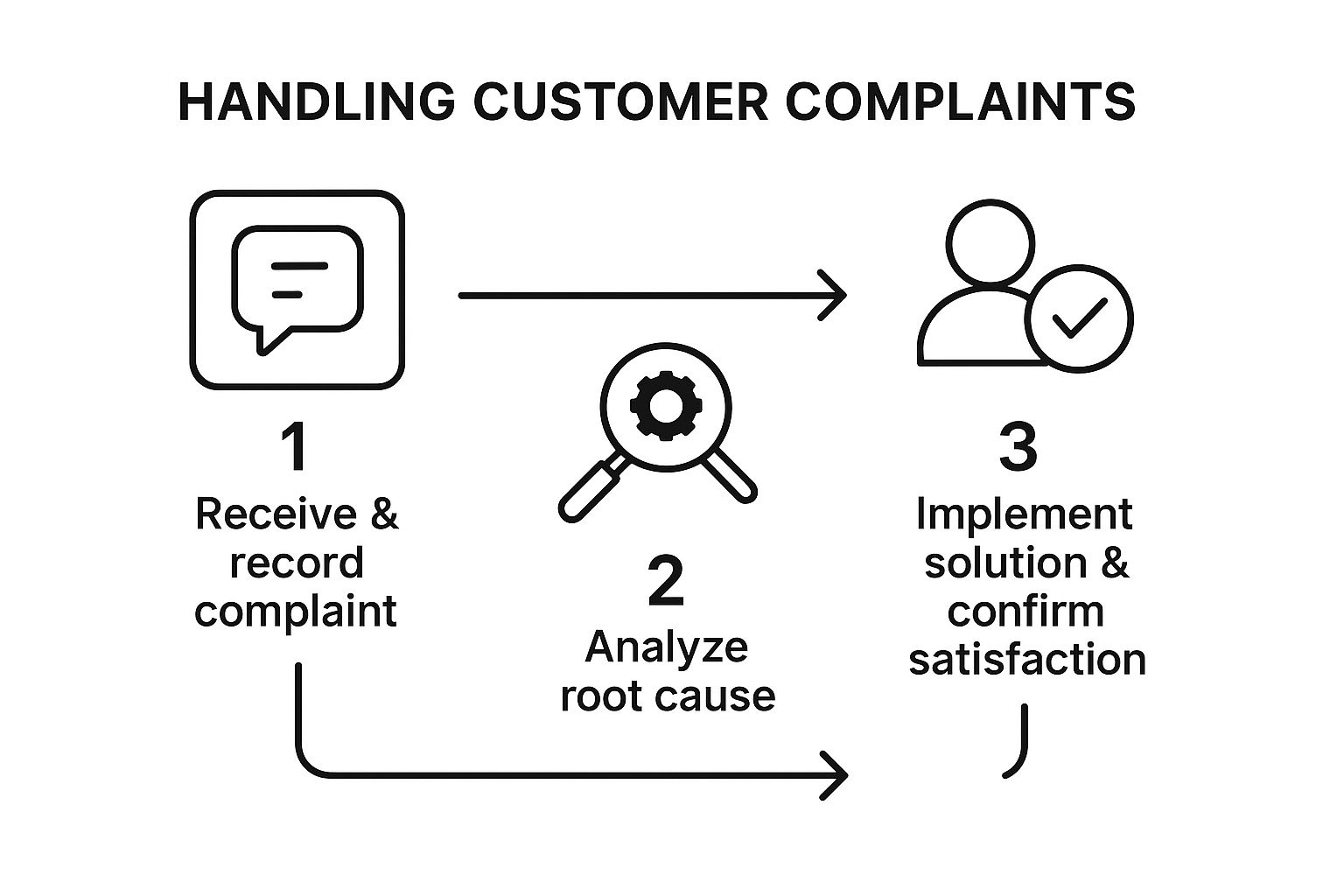How to Handle Customer Complaints: Expert Tips for Success

Let's be honest—nobody likes getting a customer complaint. That initial email or phone call can feel like a punch to the gut, and it's natural to get a little defensive. But that's a huge mistake. If you view complaints as just a problem to get rid of, you're missing the point entirely.
Think of it this way: every complaint is a free consultation. It's a customer pointing a spotlight on a blind spot you didn't even know you had—a flaw in your product, a snag in your checkout process, or a gap in your service.
The real shift happens when you stop seeing complaints as a threat and start seeing them as data. This customer cared enough to tell you what went wrong. For every one person who speaks up, how many others just quietly took their business to a competitor? This direct feedback is one of the most powerful tools you have for getting better.
Why Every Complaint Matters More Than You Think
A poorly handled complaint isn't just one lost customer. It's a ripple effect. That unhappy person is far more likely to share their bad experience—with friends, on social media, in a review—and that can poison the well for countless potential customers. The stakes are high with every single interaction.
The numbers don't lie. A staggering 57% of customers will jump ship to a competitor after just one bad experience. That leaves almost no room for error. This means that resolving an issue effectively on the first try isn't just "good service"; it's a core part of your retention strategy. Get it right, and you don't just save a customer, you often create a fiercely loyal advocate.
The customer's perception is your reality. When you resolve a complaint successfully, you're not just fixing a single issue; you're reinforcing the customer's decision to trust you in the first place.
A Practical Framework For Complaint Resolution
While every situation has its own quirks, having a solid framework helps your team respond with confidence and empathy every time. It removes the guesswork and ensures a consistent, high-quality response.
This flow chart breaks down the journey of a complaint, from the moment it lands on your desk to the final resolution.

As you can see, fixing the immediate problem is just one piece of the puzzle. The real magic happens when you dig into the root cause to make sure it never happens again.
To bring this to life, I've always relied on a simple but incredibly effective four-step process. Each step builds on the last, designed to turn a tense conversation into a productive one. Mastering this approach can dramatically boost your customer engagement and build the kind of loyalty that lasts.
Here’s a quick-reference table outlining the core strategy.
A Practical Framework for Complaint Resolution
| Step | Objective | Key Actions |
|---|---|---|
| Listen | Fully understand the customer's issue and perspective without interruption. | Let them finish speaking, take notes, and repeat key points back to confirm understanding. |
| Empathize | Acknowledge their frustration and validate their feelings. | Use phrases like, "I can see why that would be frustrating," or "I'm so sorry this happened." |
| Solve | Take ownership and provide a clear, actionable solution. | Explain the next steps, offer a fair resolution, and get their agreement on the plan. |
| Follow-Up | Confirm the resolution worked and ensure their satisfaction. | A quick email or call a few days later shows you care beyond the initial interaction. |
Committing this simple Listen, Empathize, Solve, and Follow-Up model to memory gives your team a reliable playbook for navigating even the toughest customer issues with grace and effectiveness.
Building Your Complaint Management System

Simply reacting to complaints as they pop up is a recipe for burnout and inefficiency. To truly handle customer issues at scale, you have to shift from a reactive mindset to a proactive one. Let’s be clear: great service isn't an accident. It's the result of a well-designed process that ensures nothing ever slips through the cracks.
Building a solid complaint management system is what turns that chaotic stream of feedback into organized, actionable data. It gives your team a clear playbook, so they know exactly what to do when a problem arises. This structure is the difference between constantly putting out fires and preventing them from starting in the first place.
Establish Clear Feedback Channels
First things first: make it ridiculously easy for customers to reach you. If someone has to go on a scavenger hunt just to find a contact method, their frustration is already boiling over before you've even had a chance to help. You need to control the entry points for feedback.
I always advise setting up a few dedicated channels specifically for support and complaints. This funnels all incoming issues into one place, so nothing gets lost in a general inbox or buried in a busy social media feed.
- Dedicated Email Address: Something simple and professional like
support@yourcompany.comis a must. It's easy to remember and straightforward. - Website Contact Form: A well-designed form on your site can prompt customers for the key details you'll need right away, like an order number or account ID. This cuts down on the back-and-forth.
- Social Media Listening: You'll want to use tools to monitor mentions of your brand on platforms like X (formerly Twitter) and Facebook. This helps you catch complaints from customers who don't reach out to your official channels directly.
By defining these channels, you create a system that directs every complaint into a workflow you can actually manage.
A formal system ensures that every complaint is captured, tracked, and resolved. It’s the operational backbone that turns good intentions into consistent, reliable customer service.
Implement a Ticketing System
Once the complaints start rolling in, you'll need a way to track them. A spreadsheet might feel sufficient when you're just starting out, but it will quickly become a nightmare. This is where a ticketing system becomes your best friend.
A ticketing system assigns a unique reference number to every single complaint, creating a clean, traceable record from the initial contact all the way to resolution. It forces accountability because every ticket has an owner responsible for seeing it through. This simple step eliminates the classic problems of two team members accidentally working on the same issue or, even worse, nobody working on it at all.
Many modern help desk platforms are built around ticketing, but the core principle is creating a single source of truth for every customer issue. A critical piece of this puzzle is creating internal documentation for your team; building a robust knowledge base is a fantastic way to centralize processes and answers for your agents.
Create a Categorization Matrix
Not all complaints are created equal. A software bug report needs a completely different approach than a billing question. A simple but incredibly powerful technique is to create a categorization matrix to sort your incoming tickets. This brings instant clarity and helps you spot trends you'd otherwise miss.
Let's say you run an e-commerce store. Your matrix might look something like this:
| Category | Sub-Category | Example |
|---|---|---|
| Product Issues | Damaged Item | "My coffee mug arrived cracked." |
| Missing Item | "My order was missing the blue t-shirt." | |
| Shipping & Delivery | Delayed Shipment | "My package is two weeks late." |
| Tracking Issues | "The tracking number isn't working." | |
| Billing | Incorrect Charge | "I was overcharged for my subscription." |
| Refund Request | "I need to return this and get my money back." |
Categorizing feedback this way does so much more than just tidy up your inbox. It transforms individual complaints into valuable data. If you suddenly see a 20% spike in the "Damaged Item" category, you know you have a packaging or carrier problem that needs immediate investigation. This system gives you the intel to make smarter, data-driven decisions.
Automating parts of this workflow, like assigning tickets based on their category, can be a game-changer for your team's efficiency. You can see how these principles apply more broadly in our guide on https://www.lumeo.me/en/blog/marketing-workflow-automation.
Mastering Empathetic Communication

Once your systems are in place for tracking complaints, the real work begins. This is where the human element becomes everything. A frustrated customer isn't just a ticket number in a queue; they're a person who feels let down, ignored, or even cheated.
Empathetic communication is what turns a negative interaction into a positive one. It’s about so much more than a scripted "I'm sorry." It’s about genuinely showing you understand their position and are committed to making things right.
Getting Inside The Customer's Head
When someone reaches out to complain, they’re usually running on a cocktail of emotions—anger, disappointment, and a sense of helplessness. They paid for something that didn't deliver. Your first job isn't to fix the issue; it's to defuse the emotion.
Nothing will make a customer feel more invisible than a dismissive tone or a robotic, copy-pasted reply. That kind of response screams, "We don't care." Instead, your goal should be to make them feel heard and respected from your very first sentence.
"I understand how frustrating that must be. Let's work together to figure out how we can fix this."
A simple line like this is incredibly effective. It validates their feelings, accepts a shared responsibility, and instantly shifts the tone from a confrontation to a collaboration. It says, "I'm on your side."
How to Practice Active Listening and Validation
Active listening isn't just about waiting for your turn to talk. It's a deliberate effort to grasp the heart of the problem, paying attention not just to what they're saying, but how they're saying it.
Next time you're handling a complaint, try these moves:
- Repeat It Back: After they've explained their situation, summarize it in your own words. "Okay, so if I'm hearing you correctly, the package showed up damaged, and the product inside was completely unusable. Is that right?" This proves you were listening and makes sure you're both working on the same problem.
- Ask Smart Questions: Don't just make assumptions. Dig a little deeper to get the full story. "Could you tell me a bit more about what happened right after you tried to log in?" This shows you're engaged and helps you get to the root cause faster.
- Validate Their Feelings (Without Admitting Fault): You can acknowledge someone's experience even if you don't agree with their assessment. A phrase like, "I can absolutely see why that process would feel confusing," validates their emotion without placing blame.
This approach completely changes the dynamic. Suddenly, you’re not just a faceless company representative; you're a human problem-solver who genuinely wants to help.
Choosing Words That Heal, Not Hurt
The language you choose can either be gasoline on a fire or a cool balm on a tense situation. It all starts with building an empathetic culture internally. In fact, research shows 76% of customer service employees are more engaged when they feel their leaders are empathetic, which has a direct impact on how they treat customers. You can review key customer service statistics and their impact to see the data for yourself.
It often comes down to simple word swaps. Here’s a quick cheat sheet.
| Instead Of This (Defensive & Dismissive) | Try This (Empathetic & Proactive) | Why It Works |
|---|---|---|
| "That's just our policy." | "Let me explain how this works so we can find a solution together." | It turns a dead end into a collaborative path forward. |
| "You'll have to..." | "Here’s what I can do for you right now..." | It puts the ownership on you, not the frustrated customer. |
| "I don't know." | "That's a great question. Let me find out for you." | It projects confidence and a commitment to getting answers. |
| "There's nothing I can do." | "I've hit my limit on what I can do, but let me see if my manager can help." | It shows you're still their advocate, even when you're stuck. |
Let's put this into practice. Imagine a customer is livid because their software subscription auto-renewed without them realizing it.
- Bad response: "Our terms of service, which you agreed to, state that all subscriptions auto-renew. We can’t offer a refund."
- Good response: "I can definitely see how an unexpected charge would be frustrating, and I'm sorry for the surprise. Let's pull up your account together and review your subscription settings to see what our options are."
The first reply might be factually correct, but it creates an adversary. The second acknowledges the customer's feeling, sidesteps blame, and immediately focuses on finding a solution. These small but critical shifts in language are what separate mediocre service from legendary support. It’s how you turn an unhappy customer into a loyal fan.
Turning Complaint Data into Business Insights

Solving one customer's problem is good. Preventing hundreds of future problems? That's a total game-changer.
Once you have a solid system for logging complaints, the real work begins. It’s time to stop treating each issue as a one-off fire to extinguish and start seeing the feedback for what it is: a goldmine of business intelligence. This is the pivot from being reactive to becoming truly proactive.
Think of every complaint as a breadcrumb trail leading back to a crack in your customer experience. A single negative comment might just be an outlier. But a pattern of similar feedback is a bright, flashing neon sign that something fundamental is broken and needs to be fixed.
The goal is to move beyond simply closing tickets and start digging for the root cause. This shift is absolutely crucial for retention. In fact, an incredible 67% of customer churn could be prevented if companies resolved issues on the first try. You can dig into more customer service findings to see the full picture. By analyzing data to stop these problems from ever happening, you build a much more resilient business.
Performing a Root Cause Analysis
When you start seeing the same complaint pop up over and over, your first instinct might be to just apologize and issue a refund. But a far more powerful approach is to perform a root cause analysis to uncover the why behind the what.
This just means asking a series of "why" questions until you hit the core of the issue.
Let's say your e-commerce store keeps getting complaints about customers receiving the wrong T-shirt size.
- The Problem: Customers are getting the wrong size.
- Why? Because the picking slip shows the wrong size.
- Why? The data entry team is making mistakes when keying in orders from one of our sales channels.
- Why? The SKU numbers for different sizes are nearly identical, making them incredibly easy to mix up.
Just like that, you've gone from blaming an individual to identifying a systemic flaw. The real solution isn't just retraining one person; it's redesigning your SKU system to be less prone to human error. That's how you stop the problem for good.
Connecting Complaints to Business Functions
The insights you gather are only valuable if they get to the right people. Your customer service team is on the front lines, but they can't redesign a product or rewrite a marketing campaign on their own. This is where creating a clear feedback loop between departments becomes essential.
To get the ball rolling, you need to route feedback to the team that can actually fix the underlying issue. A lot of the time, the complaint a customer voices is just a symptom of a deeper problem elsewhere in the business.
Common Complaint Types and Their Root Causes
Here's a simple table to help you connect the dots between what customers are saying and who needs to hear it.
| Common Complaint | Potential Root Cause | Department to Involve |
|---|---|---|
| "The website is confusing to navigate." | Poor user interface (UI) or user experience (UX) design. | Product/Web Dev |
| "The product didn't do what the ad promised." | Misleading marketing copy or visuals. | Marketing |
| "My package arrived damaged." | Inadequate packaging materials or shipping carrier issues. | Operations/Logistics |
| "Your support agent couldn't help me." | Insufficient training or lack of access to the right tools. | Support Management |
| "The feature I need is missing." | The product roadmap is misaligned with user needs. | Product Management |
This framework helps you turn raw customer feedback into specific, actionable tasks for other teams. Of course, for any of this to work, you have to truly know your customers, which is where a deep target audience analysis comes in.
By treating your complaint log as a strategic asset, you turn the voice of your most frustrated customers into your most powerful tool for improvement.
Ultimately, this process transforms customer service from a cost center into a vital hub of business intelligence. It helps create a culture where every single team feels ownership over the customer experience. When the product team sees how a tiny bug is generating dozens of support tickets, they’re motivated to fix it. This is how you build a genuinely customer-centric organization.
Empowering Your Team for First-Contact Resolution
You can have the most sophisticated systems and perfectly crafted scripts, but your complaint handling process is only as good as the people on the front lines. If your agents feel powerless, you'll never really get ahead. The magic happens with first-contact resolution (FCR)—solving a customer's issue in one shot, with no transfers or escalations.
Think about it from the customer’s perspective. Hearing an agent say, "I need to ask my manager," instantly doubles their frustration. It sends a message, loud and clear: "You're not important enough for the person you're actually talking to." This single bottleneck is where customer loyalty goes to die.
Granting Authority and Setting Boundaries
Real empowerment begins with trusting your team to make decisions. This means giving your frontline agents the actual authority to offer solutions on the spot, whether that’s a partial refund, a discount on a future order, or shipping a replacement product. Without that trust, they’re not problem-solvers; they’re just human shields.
Of course, this isn't about giving them a blank check. The trick is to establish clear, common-sense guidelines that everyone understands. For example, you might empower every agent to:
- Offer a full refund for any order under $50 without needing a manager’s approval.
- Provide a 15% discount code for a future purchase as a simple gesture of goodwill.
- Reship a product immediately, at no cost, if a customer reports it arrived damaged.
These simple rules give your team the tools they need to resolve the vast majority of common problems right away. They know their boundaries but have the freedom to operate confidently within them.
When you empower an employee, you're not just giving them permission to act. You're telling them, "I trust your judgment," which builds the confidence they need to handle difficult conversations with grace.
This approach doesn’t just make customers happier; it dramatically speeds up your resolution times. Instead of waiting days for a manager to review their case, they get an immediate, satisfying solution.
Building a Comprehensive Training Program
Authority without knowledge is a recipe for disaster. A truly empowered team needs deep expertise in both your products and your service philosophy. Your training program shouldn't just be a one-off onboarding session; it needs to be an ongoing process.
A solid training curriculum is the bedrock of great service. It gives agents the skills to navigate complex and emotionally charged situations, turning them from support reps into genuine brand ambassadors.
Essential Training Modules
Your program should focus on a few key areas to build a well-rounded team.
Deep Product Knowledge: Agents have to know your products inside and out. They need to be able to answer technical questions, explain niche features, and troubleshoot common issues without having to put the customer on hold to look everything up. This requires regular refreshers, especially when you launch new products or push updates.
De-escalation Techniques: This is absolutely non-negotiable. Your training has to include role-playing tough scenarios where agents practice managing customer anger, validating their feelings, and steering conversations toward a positive outcome. They need to learn how to stay calm and professional, even when a customer is being completely unreasonable.
Company Policies and Procedures: It's not enough for your team to know what the policies are; they need to understand the why behind them. When an agent can confidently explain the reasoning for a return policy, they can communicate it with far more empathy.
By investing here, you're teaching them more than just how to handle complaints. You're developing skilled communicators who can protect and even enhance your brand’s reputation with every interaction.
Equipping Your Team with The Right Tools
Finally, even the best-trained agent will stumble if they're fighting with clunky software. Your tech stack needs to be an asset, not a hurdle. The goal is to give your team a complete, single-pane view of every customer's history.
When an agent pulls up a customer’s file, they should instantly see:
- Past purchase history
- Previous support tickets and their outcomes
- Notes from conversations with other agents
A modern Customer Relationship Management (CRM) platform is essential for this. It eliminates the need for a customer to repeat their story every time they talk to someone new—which is one of the most infuriating parts of bad service. This single source of truth allows any agent to pick up the conversation with full context, making the entire experience seamless.
How to Handle Common Complaint Scenarios
Theory is one thing, but knowing how to handle customer complaints really comes down to navigating the messy, real-world situations that don't fit neatly into a process chart. When a customer is fuming on social media or insisting on something that’s just plain wrong, a standard script isn't going to help.
This section gets into those tricky, nuanced challenges that pop up every day. Think of it as your field guide for some of the most common—and most difficult—complaint scenarios your team will ever face.
Responding to Complaints on Social Media
A complaint on a public platform like X or Instagram is a high-stakes performance. Your response isn't just for one person; it's for every follower, customer, and competitor watching. The key is to perfectly balance public accountability with private resolution.
Your first move should always be a swift, public reply. Acknowledge their issue directly in the comments. A simple, "We're so sorry to hear about this experience. We've sent you a DM to get more details and help make this right," is perfect.
This immediate, visible action shows everyone you're on top of it and taking the matter seriously. From there, you move the conversation to a private channel like DMs to handle sensitive account details and figure out a real solution. This approach protects customer privacy while proving you don't hide from problems.
A public complaint is a test of your company's character. Handle it with speed and transparency, and you can turn a potential PR crisis into a display of excellent customer care.
When the Customer Is Wrong but Insistent
This is one of the most delicate situations in customer service. The goal is to correct the misinformation without making the customer feel stupid or cornered. A blunt "you're wrong" will only pour gasoline on the fire.
Instead, start by validating their frustration. You could say something like, "I can definitely see why that part of the process would be confusing, and I really want to help clear things up." You're acknowledging their feeling without agreeing with their incorrect conclusion.
From there, you can gently guide them toward the correct information. Collaborative language is your best friend here.
- "Let's walk through the policy together so we can get on the same page."
- "Could you show me where you're seeing that? I want to make sure I understand correctly."
This reframes the interaction from a confrontation into a joint problem-solving session. You preserve the relationship by helping them save face while still steering them to the right answer.
Differentiating a Complaint from Feedback
It’s easy to lump all negative comments together, but there’s a massive difference between a complaint and general feedback. Getting this right helps you prioritize and respond in the most effective way.
A complaint is tied to a specific failure or negative experience that needs a fix, right now. For example, "My order arrived with a broken part, and I need a replacement." This is an urgent fire that needs to be put out.
Feedback, on the other hand, is more of a suggestion or observation meant to help you improve. It can be positive or negative but doesn't usually demand a personal fix for that specific user. Think, "I really wish your app had a dark mode feature."
Both are incredibly valuable, but they trigger different actions. Complaints demand urgent, personal resolution. Feedback gets logged, categorized, and used to inform your future strategy.
Deciding When to Offer Compensation
So, should you offer a discount or refund for every single complaint? Not necessarily. The resolution should always be proportional to the size of the problem. Overcompensating for minor hiccups can set unsustainable expectations for the future.
For a small inconvenience, like a slight shipping delay, a sincere apology and a quick update are often enough. But for a major service failure that caused real trouble for the customer, compensation is a powerful tool for restoring goodwill. This could be a refund, a store credit, or even a free product.
The best thing you can do is empower your team with clear guidelines on what they can offer without needing a manager's approval. This allows them to make fair, consistent judgments on the fly. To dig deeper into this, you might explore this detailed guide on how to handle customer complaints like a pro.
Turning feedback and even complaints into compelling content is a great way to show you're listening. With Lumeo, you can easily transform customer insights or FAQs into engaging carousels for social media, helping you educate your audience and build trust. Start creating for free today at https://lumeo.me.